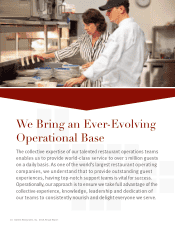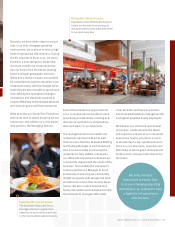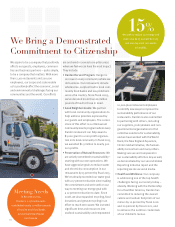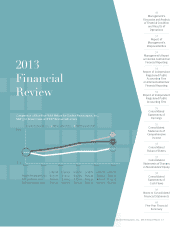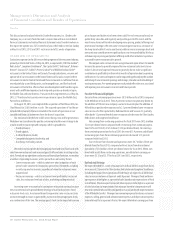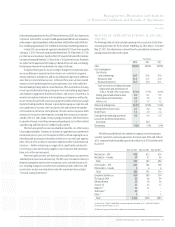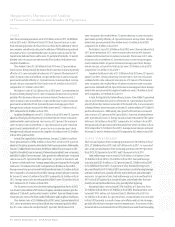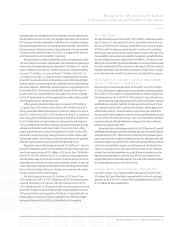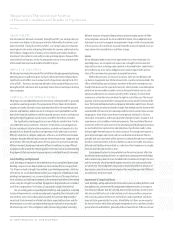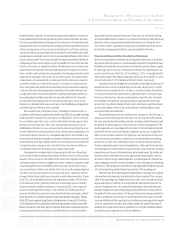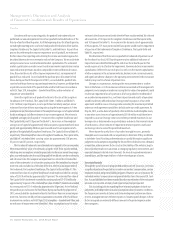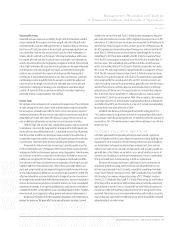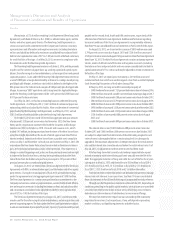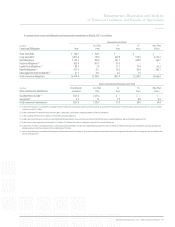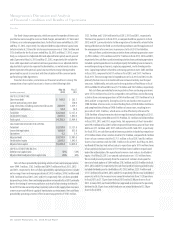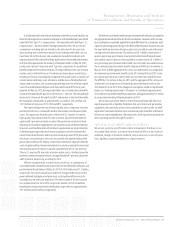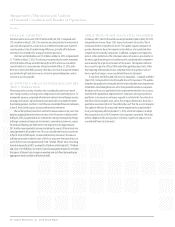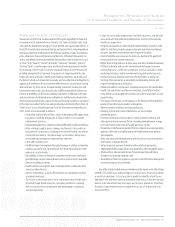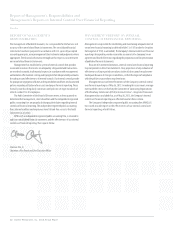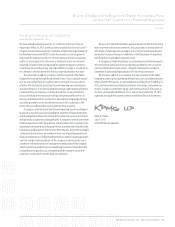Red Lobster 2013 Annual Report Download - page 28
Download and view the complete annual report
Please find page 28 of the 2013 Red Lobster annual report below. You can navigate through the pages in the report by either clicking on the pages listed below, or by using the keyword search tool below to find specific information within the annual report.
Management’s Discussion and Analysis
of Financial Condition and Results of Operations
Darden
24 Darden Restaurants, Inc. 2013 Annual Report
Consistent with our accounting policy for goodwill and trademarks, we
performed our annual impairment test of our goodwill and trademarks as of the
first day of our fiscal fourth quarter. As of the beginning of our fiscal fourth quarter,
we had eight reporting units, six of which had goodwill: Red Lobster, Olive Garden,
LongHorn Steakhouse, The Capital Grille, Eddie V’s, and Yard House. As part of our
process for performing the step one impairment test of goodwill, we estimated
the fair value of our reporting units utilizing the income and market approaches
described above to derive an enterprise value of the Company. We reconciled the
enterprise value to our overall estimated market capitalization. The estimated
market capitalization considers recent trends in our market capitalization and an
expected control premium, based on comparable recent and historical transac-
tions. Based on the results of the step one impairment test, no impairment of
goodwill was indicated. As we finalized the purchase price allocation for Yard
House during our fourth fiscal quarter of 2013, we excluded the goodwill allo-
cated to Yard House from our step one impairment test, however, we did perform
a qualitative assessment of the goodwill allocated to Yard House in accordance
withASCTopic350,Intangibles–GoodwillandOther,andnoindicatorsof
impairment were identified.
Given the significance of goodwill relative to the size of the LongHorn
Steakhouse ($49.5 million), The Capital Grille ($401.7 million) and Eddie V’s
($22.1 million) reporting units, we also performed sensitivity analyses on our
estimated fair value of these reporting units using the income approach. A key
assumption in our fair value estimate is the weighted-average cost of capital utilized
for discounting our cash flow estimates in our income approach. We selected a
weighted-average cost of capital of 11.0 percent for LongHorn Steakhouse and
The Capital Grille, and 17.0 percent for Eddie V’s. An increase in the weighted-
average cost of capital of approximately 436 basis points, approximately 263 basis
points and approximately 200 basis points would result in an impairment of a
portion of the goodwill of LongHorn Steakhouse, The Capital Grille and Eddie V’s,
respectively. The estimated fair values of LongHorn Steakhouse, The Capital Grille,
and Eddie V’s exceeded their carrying values by approximately 108 percent,
45 percent and 47 percent, respectively.
The fair value of trademarks are estimated and compared to the carrying value.
We estimate the fair value of trademarks using the relief-from-royalty method,
which requires assumptions related to projected sales from our annual long-range
plan;assumedroyaltyratesthatcouldbepayableifwedidnotownthetrademarks;
and a discount rate. We recognize an impairment loss when the estimated fair
value of the trademarks is less than the carrying value. We completed our impair-
ment test and concluded as of the date of the test, there was no impairment of
the trademarks for LongHorn Steakhouse, The Capital Grille and Eddie V’s. The
estimated fair value of LongHorn Steakhouse’s trademark exceeded its carrying
value of $307.0 million by approximately 91 percent. The estimated fair value of
The Capital Grille’s trademark exceeded its carrying value of $147.0 million by
approximately 56 percent. The estimated fair value of Eddie V’s trademark exceeded
its carrying value of $10.5 million by approximately 50 percent. As we finalized
the purchase price allocation for Yard House during our fourth fiscal quarter of
2013, we excluded the trademark related to Yard House from our annual impair-
ment test, however, we did perform a qualitative assessment of the Yard House
trademarkinaccordancewithASCTopic350,Intangibles–GoodwillandOther,and
no indicators of impairment were identified. A key assumption in our fair value
estimate is the discount rate utilized in the relief-from-royalty method. We selected
a discount rate of 12.0 percent for LongHorn Steakhouse and The Capital Grille,
and 18.0 percent for Eddie V’s. An increase in the discount rate of approximately
679 basis points, 371 basis points and 463 basis points would result in impairment
of a portion of the trademarks of LongHorn Steakhouse, The Capital Grille and
Eddie V’s, respectively.
We determined that there was no goodwill or trademark impairment as of
the first day of our fiscal 2013 fourth quarter and no additional indicators of
impairment were identified through the end of our fiscal fourth quarter that
would require us to test further for impairment. However, declines in our market
capitalization (reflected in our stock price) as well as in the market capitalization
of other companies in the restaurant industry, declines in sales at our restaurants,
and significant adverse changes in the operating environment for the restaurant
industry may result in a future impairment loss.
Changes in circumstances, existing at the measurement date or at other
times in the future, or in the numerous estimates associated with management’s
judgments and assumptions made in assessing the fair value of our goodwill, could
result in an impairment loss of a portion or all of our goodwill or trademarks. If
we recorded an impairment loss, our financial position and results of operations
would be adversely affected and our leverage ratio for purposes of our credit
agreement would increase. A leverage ratio exceeding the maximum permitted
under our credit agreement would be a default under our credit agreement. At
May 26, 2013, a write-down of goodwill, other indefinite-lived intangible assets,
or any other assets in excess of approximately $810.0 million would have been
required to cause our leverage ratio to exceed the permitted maximum. As our
leverage ratio is determined on a quarterly basis and due to the seasonal nature
of our business, a lesser amount of impairment in future quarters could cause
our leverage ratio to exceed the permitted maximum.
We evaluate the useful lives of our other intangible assets, primarily
intangible assets associated with our acquisitions, to determine if they are definite
or indefinite-lived. Reaching a determination on useful life requires significant
judgments and assumptions regarding the future effects of obsolescence, demand,
competition, other economic factors (such as the stability of the industry, legisla-
tive action that results in an uncertain or changing regulatory environment, and
expected changes in distribution channels), the level of required maintenance
expenditures, and the expected lives of other related groups of assets.
Insurance Accruals
Through the use of insurance program deductibles and self-insurance, we retain
a significant portion of expected losses under our workers’ compensation, certain
employee medical and general liability programs. However, we carry insurance for
individual workers’ compensation and general liability claims that exceed $0.5 mil-
lion. Accrued liabilities have been recorded based on our estimates of the anticipated
ultimate costs to settle all claims, both reported and not yet reported.
Our accounting policies regarding these insurance programs include our
judgments and independent actuarial assumptions about economic conditions,
the frequency or severity of claims and claim development patterns and claim
reserve, management and settlement practices. Unanticipated changes in these
factors may produce materially different amounts of reported expense under
these programs.


